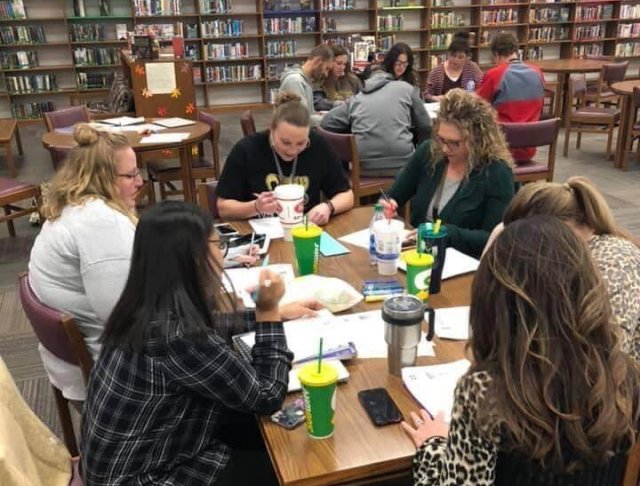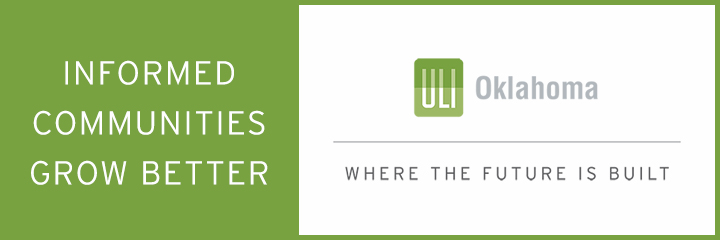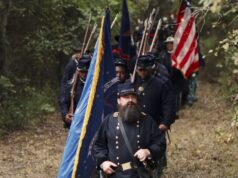

When Atoka Public Schools Superintendent Jay McAdams thinks about the importance of mental health resources in schools, he remembers a story from a man he knows.
“He lost his mom when he was 9 years old,” McAdams said. “We talked about how when trauma occurs to kids, the brain develops differently and how some people are able to overcome it and some people aren’t.”
For that man, starting to overcome the trauma of losing his mother in a tragic accident came a decade later, when an older woman at the post office offered a signal of caring just by asking how he was and offering words of encouragement. But what if the man had been able to find the support he needed sooner?
McAdams hopes that programs like Oklahoma’s Project AWARE can help schools be that resource for students.
“We could be that person for so many kids,” McAdams said. “What I’m excited about most is for our teachers to better understand the trauma our students have dealt with — being made aware of what’s going on in kids’ lives and forcing ourselves as educators to think. Sometimes we can forget and think that our job is to just teach that math, reading and science, but sometimes we’re the only things that these kids have to keep them going.”
In October, the Oklahoma State Department of Education received a five-year grant that will total nearly $9 million to help develop a more integrated mental health approach for the students and families of Atoka, Ada and Checotah Public Schools.
The Oklahoma AWARE East grant comes from the U.S. Department of Mental Health and Substance Abuse Services and builds on Project AWARE, a program that has proven beneficial for Elk City, Weatherford and Woodward Public Schools, where it has been in place since 2018.
The support provided by Project AWARE includes trauma-informed training for teachers, licensed counselors for each school district and the development of a community-based approach to mental health.
A ‘mental health desert’
The State Department of Education’s deputy superintendent of Project AWARE, Shelly Ellis, said the program has filled a need for western Oklahoma, which is considered to be a mental health desert.
“A mental health desert means that there’s a low number of licensed mental health professionals in their area to serve their community,” Ellis said. “They lacked a robust mental health base.”
The University of Kansas SWIFT Center provides training and professional development services for the program, with an emphasis on establishing a multi-tiered system of support, also called an MTSS.
Fun Fact: The MTSS analogy in the book was almost a poke bowl instead of an ice cream sundae. – D pic.twitter.com/fiUeEXf6XW
— SWIFT Schools (@SWIFTSchools) October 2, 2020
“A multi-tiered system of support really looks at how we help our students in the way that they need to be helped,” Ellis said. “Through the AWARE grant, we’re integrating that [multi-tiered system of support] based on what each individual student needs in a mental health way.”
The first tier of the system includes the basic mental health curriculum that every student will receive. Ellis said this tier of support is sufficient for about 80 to 85 percent of students.
Tier 2 interventions help students who may need a little more than just the universal support students receive, such as help with managing general anxiety.
Tier 3 provides more extensive one-on-one help to students and applies to 2 or 3 percent of the student population.
“A lot of schools have a MTSS for academics and behavior, but integrating an MTSS around mental health and social-emotional learning is what we’re really doing with the AWARE grant,” Ellis said.
Ada Public Schools counselor Ali Lawson said that changing demographics in her district have revealed a high need for these mental health services.
“We’re seeing a whole lot more mental health issues because of being homeless or not having enough money to pay the electric bill or water bill,” Lawson said.
‘Our student needs are very high’
The Oklahoma Prevention Needs Assessment, a survey given to students in sixth, eighth, 10th and 12th grades, measures mental health needs in students as well as tendencies toward behaviors such as bullying, violence, drugs and alcohol.
Amy Whitewater, the Project AWARE community manager for Woodward Public Schools, said a shortage of school counselors and licensed health practitioners, combined with the district’s scores on the assessment, made Woodward Public Schools a prime candidate for the grant in 2018.
“One of the goals of Project AWARE is to increase those numbers of those different professionals within not just the school district, but the community,” she said. “Our student needs are very high.”
🧡🤍Our elementary schools celebrated Unity Day on Wednesday! Students, faculty, and staff wore orange to support the prevention of bullying and to promote kindness, acceptance, and inclusion! #KindnessCounts #UnityDay #OklaEd #ProjectAWARE
OK AWARE🧡🤍 pic.twitter.com/Ek7kjf9bj2— WPSBoomers (@WPSBoomers) October 23, 2020
At the onset of the grant, Woodward hired a local licensed clinical social worker to act as their Project AWARE counselor on a referral basis, with the grant paying for the full service cost or co-pay for services.
“If a principal or counselor feels like they have a student who needs some extra support that the school counselor can’t provide, they’ll send a referral for her to see that student,” Whitewater said.
The Project AWARE counselor will get parental consent and meet with the student to determine what their needs are. If needed, she will meet with those students once a week at school or virtually. If her schedule gets too full, she will refer the student to another local provider.
“She had 143 referrals last year,” Whitewater said. “That’s a lot of kids who needed services and a lot of kids that, before this grant, probably wouldn’t have gotten the services that they needed.”
Whitewater said one of the biggest changes with the Project AWARE grant is that every faculty and staff member must complete the Youth Mental Health First Aid training. Nearly 400 faculty members at Woodward schools have completed the program since Project AWARE began.
“The training helps them better understand a mental health crisis in a student, how to recognize that red-flag behavior and how to implement what we would call classroom first aid,” she said.
Educators are trained in how to assess whether a student may be experiencing a mental health crisis or developing the symptoms of a mental health condition. They are trained to bring the situation to the attention of a counselor.
“Basically, it teaches adults signs and symptoms to look for to get the kids the help that they need,” Lawson said. “Looking at typical adolescent behavior versus what could be a mental health issue.”
Whitewater said the implementation of community nights through the AWARE grant has also been beneficial in fighting the stigma associated with mental health issues. These events involve bringing in guest speakers and other activities to the community that elevate conversations about mental health.
“One of our big goals is to help reduce and eliminate that stigma that is associated with seeking out help for mental health,” she said.
‘We’ve seen a huge increase in requests for mental health services’
The State Board of Education included $18.2 million for counselors in their FY 2020 legislative budget request in order to meet the recommended national ratio of one counselor for every 250 students.
Stephanie Perkins, licensed professional counselor at Weatherford Public Schools, said having a program like Project AWARE has been an asset to the community throughout the pandemic.
Officials at Woodward and Weatherford Public Schools said they have seen an uptick in students seeking out mental health care this school year.
Whitewater said Woodward has already seen 48 referrals this school year, which puts them on track to surpass last year’s total of 143 referrals. She believes the pandemic and economic issues caused by it have been contributing factors.
“The issues of the pandemic have been affecting families tremendously,” Whitewater said. “We did virtual school and then the oil field crashed as well. Our families in northwest Oklahoma are really suffering because of the economics. We’ve seen a combination of both of those things that have played into a higher demand for mental health services. We have a lot of kids whose families are stressed over economics, they’re stressed because of COVID-19, and they’ve been at home for five months. They haven’t had their social interactions with their peers. They haven’t had a daily schedule and a routine.”
While students are starting to work their way back into routines, Whitewater said they still need a lot of support.
Teachers in the Weatherford school district have started each day this semester by leading their classrooms in circle time — a time for students to express any concerns they have, pandemic-related or otherwise.
“We’ve seen a lot of kids expressing a lot of anxiety and a lot of stress,” Perkins said. “We’ve seen a huge increase in requests for mental health services. I feel like Project AWARE has been good in that aspect. It feels like this is just a time of such stress, and the kids need it and the families need it and the teachers need it, so us being here has been so helpful.”
Perkins said it has been beneficial to have two licensed professional counselors available to meet with students weekly if needed.
“There are so many kids who need therapy and need help and, then there are so many parents that can’t get their children to therapy,” Perkins said.
https://twitter.com/OklahomaKids/status/1245702498100396033
If the services a student needs extend beyond the capacity of the licensed counselors at Weatherford schools, they are referred to Red Rock Behavioral Health Services, where services are covered by the grant.
Perkins said the Project AWARE counselors and community manager also work to provide sustainability measures.
“All of the students and teachers will know how to handle those panic attacks, kids with trauma and those situations that are so hard that we’re handling right now,” Perkins said.
She said students have showed resilience throughout the pandemic, but she has seen them start to struggle with anxiety about going back to school, being overwhelmed by classroom work and the looming potential of another quarantine.
“Before now, I didn’t realize how needed (Project AWARE) was, how much we were lacking in those resources and how much our children and our families need counselors in the school every day to respond to panic attacks and trauma,” Perkins said. “I hope that it can continue and spread to other schools.”
(Editor’s note: NonDoc editor in chief Tres Savage is a nationally certified Youth Mental Health First Aid instructor who has trained educators in YMHFA at both Woodward and Weatherford Public Schools as part of Project AWARE.)




















